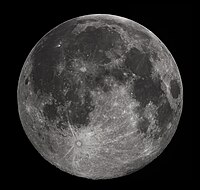
Photo from wikipedia
TIME is a mm-wavelength grating spectrometer array that will map fluctuations of the 157.7-$$\mathrm {\upmu m}$$μm emission line of singly ionized carbon ([CII]) during the epoch of reionization (redshift z$$\sim… Click to show full abstract
TIME is a mm-wavelength grating spectrometer array that will map fluctuations of the 157.7-$$\mathrm {\upmu m}$$μm emission line of singly ionized carbon ([CII]) during the epoch of reionization (redshift z$$\sim $$∼ 5–9). Sixty transition-edge sensor (TES) bolometers populate the output arc of each of the 32 spectrometers, for a total of 1920 detectors. Each bolometer consists of gold absorber on a $$\sim $$∼ 3 $$\times $$× 3 mm silicon nitride micro-mesh suspended near the corners by 1 $$\times $$× 1 $$\times $$× 500 $$\upmu $$μm silicon nitride legs targeting a photon-noise-dominated NEP $$\sim 1 \times 10^{-17}\,\mathrm {W/\sqrt{Hz}}$$∼1×10-17W/Hz. Hafnium films are explored as a lower-$$T_\mathrm{c}$$Tc alternative to Ti (500 mK) for TIME TESs, allowing thicker support legs for improved yield. Hf $$T_\mathrm{c}$$Tc is shown to vary between 250 and 450 mK when varying the resident Ar pressure during deposition. Magnetic shielding designs and simulations are presented for the TIME first-stage SQUIDs. Total axial field suppression is predicted to be $$5 \times 10^7$$5×107.
Journal Title: Journal of Low Temperature Physics
Year Published: 2018
Link to full text (if available)
Share on Social Media: Sign Up to like & get
recommendations!